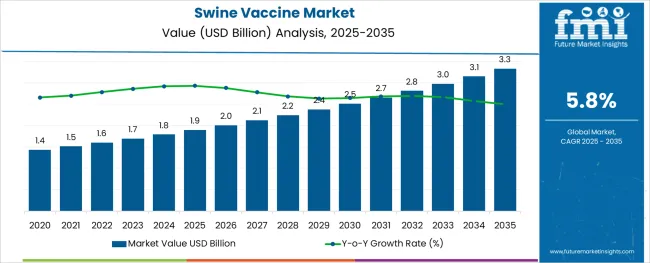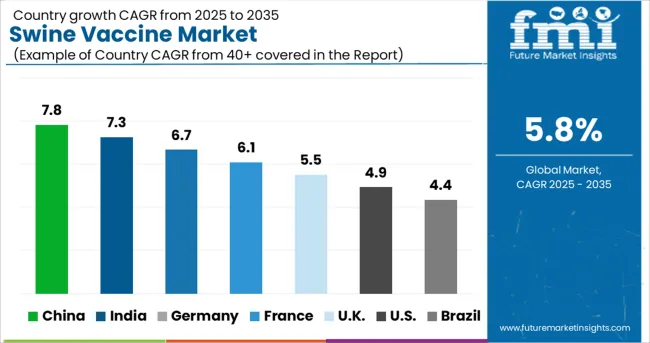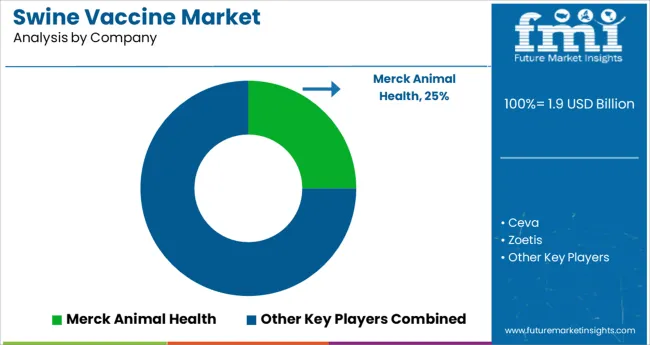The Swine Vaccine Market is estimated to be valued at USD 1.9 billion in 2025 and is projected to reach USD 3.3 billion by 2035, registering a compound annual growth rate (CAGR) of 5.8% over the forecast period.

The swine vaccine market is undergoing notable growth as the global pork industry intensifies efforts to mitigate the impact of infectious diseases on herd productivity and food security. Increasing incidences of viral and bacterial outbreaks have heightened the demand for effective immunization programs, while evolving biosecurity standards continue to influence vaccination strategies.
Industry initiatives to improve animal health and minimize antibiotic use have reinforced the adoption of advanced vaccines as a sustainable solution. Future expansion is expected to be driven by technological innovation in vaccine development, rising awareness among swine producers about preventive healthcare, and supportive government policies promoting livestock vaccination programs.
Enhanced focus on herd immunity, combined with rising investments in research and development, is paving the way for broader adoption across both commercial and small-scale farming operations.
The market is segmented by Type and Product and region. By Type, the market is divided into Porcine Circovirus Type 2, Swine Influenza, Classical Swine Fever, Porcine Parvovirus, M.Hyo, Actinobacillus Pleuropneumonia, and Foot & Mout. In terms of Product, the market is classified into Inactivated Vaccines, Attenuated Live Vaccines, Subunit Vaccines, DNA Vaccines, and Recombinant Vaccines. Regionally, the market is classified into North America, Latin America, Western Europe, Eastern Europe, Balkan & Baltic Countries, Russia & Belarus, Central Asia, East Asia, South Asia & Pacific, and the Middle East & Africa.
The market is segmented by Type and Product and region. By Type, the market is divided into Porcine Circovirus Type 2, Swine Influenza, Classical Swine Fever, Porcine Parvovirus, M.Hyo, Actinobacillus Pleuropneumonia, and Foot & Mout. In terms of Product, the market is classified into Inactivated Vaccines, Attenuated Live Vaccines, Subunit Vaccines, DNA Vaccines, and Recombinant Vaccines. Regionally, the market is classified into North America, Latin America, Western Europe, Eastern Europe, Balkan & Baltic Countries, Russia & Belarus, Central Asia, East Asia, South Asia & Pacific, and the Middle East & Africa.
When segmented by type, porcine circovirus type 2 is anticipated to account for 23∙5 of the total market revenue in 2025, establishing itself as the leading type segment. This position has been strengthened by the widespread prevalence of the virus and its significant economic impact on swine herds, necessitating routine vaccination.
The segment’s prominence is attributed to the ability of these vaccines to reduce mortality, improve growth performance, and enhance feed efficiency, thereby improving overall profitability for producers. The incorporation of porcine circovirus type 2 vaccines into standard herd health protocols has become common practice due to their demonstrated effectiveness in controlling disease outbreaks.
Enhanced understanding of the virus’s pathogenesis and its synergistic impact with other infections has further underscored the critical role of this segment in safeguarding herd health and productivity.
When segmented by product, inactivated vaccines are projected to hold 27∙0 of the market revenue in 2025, securing their position as the leading product segment. The dominance of inactivated vaccines has been reinforced by their proven safety profile and stability, making them highly suitable for widespread use in diverse farming environments.
Their ability to induce strong humoral immunity without the risk of reverting to virulence has made them a preferred choice for swine producers prioritizing biosecurity. Advances in adjuvant technologies and formulation methods have enhanced the efficacy and duration of protection offered by inactivated vaccines, contributing to their sustained demand.
The scalability of production and compatibility with multi-dose schedules have further positioned this segment as a reliable and trusted solution within comprehensive herd health management programs.
As per the Swine Vaccine Market research by Future Market Insights - a market research and competitive intelligence provider, historically, from 2020 to 2024, the market value of the Swine Vaccine increased at a CAGR of around 4.9%, while the USA held the majority share of over 35% in the global market.
The market is being driven by increased disease prevalence, increased demand for animal protein, and increased Research and Development expenditure for vaccine innovation. Owing to this, the market for Swine Vaccines is projected to grow at a CAGR of 5.8% during the forecasted period.
Some of the key factors driving the growth of the Swine Vaccine market are the rising prevalence of swine diseases like PPV, Porcine Reproductive and Respiratory Syndrome (PRRS), and Classical Swine Fever, which are likely to cause economic losses due to their negative effects on reproduction and growth in pig farms.
Swine meat is vital for agriculture-based countries and it considerably affects domestic and international trade. Contagious diseases have a global impact on pig health, as well as the swine industry's stability and production. As a result, the increased prevalence of swine disease is expected to boost the market in the coming years.
Putting in place a pig vaccination program helps in protecting them from infectious diseases at every stage of their development. As a result, businesses are concentrating on providing immunization services to assist farmers to manage bacteria and viruses more effectively.
The rise in demand for animal protein, along with rising consumer preferences for a low-fat, high-protein diet like pork has resulted in a significant increase in animal protein consumption around the world.
APAC dominated the Swine Vaccine Market, where China led the regional demand. The consumption of beef and pork is higher in middle-income countries, particularly in Southeast Asia.
In addition, emerging infectious diseases in the region, such as swine fever, drive product demand even further. In India, CSF results in an annual loss of approximately 400 crores. As a result, the Indian government is placing a greater emphasis on the development of new vaccines. In October 2020, for example, the ICAR-Indian Veterinary Research Institute developed two diagnostic kits for Swine Control and Antigen Detection. These factors are leading to the expansion of the swine vaccine market in APAC.

The market for swine vaccines in the USA is expected to reach a valuation of USD 3.3 Million by 2035. With a CAGR of 6% during the forecast period, the market in the country is projected to gross an absolute dollar opportunity of USD 137 Million.
The market in the UK is projected to reach a valuation of USD 112 Million by 2035. Growing at a CAGR of 6.1% during the forecast period, the market is expected to garner an absolute dollar opportunity of around USD 48 Million.
In China, the market is projected to expand at a CAGR of 6.9% during 2025 to 2035. The market in the country is projected to reach USD 1.1 Billion by 2035, grossing an absolute dollar opportunity of USD 463 Million during the forecast period.
In Japan, the market is expected to reach a valuation of USD 224 Million by 2035. With a CAGR of 7.5%, the market in the country is expected to gross an absolute dollar opportunity of USD 96 Million by 2035.
The market for Inactivated Vaccines is gaining the utmost traction and is expected to grow at a CAGR of 5.9% between 2025 and 2035. This increase in growth is attributable to easy availability, low cost, low risk of revert reaction of destroyed viruses, and fresh advances by key companies. For Example, PARVOVAX and PROGRESSIS vaccines were developed to fight against Porcine parvovirus and PRRS.
From 2025 to 2035, the recombinant vaccine category is projected to grow at the fastest rate. Because recombinants can carry many gene inserts, these vaccines are expected to aid in the vaccination of multiple viral strains.
Porcine Circovirus Type 2 is expected to dominate the global market and is expected to grow with a CAGR of 5.6% during the forecast period. PCV2 is the single-stranded DNA having the highest mutation and recombination rate among all single-stranded DNA viruses. It can be spread through an infected pig and is one of the most prevalent infectious agents affecting pig productivity. As a result, during the forecast period, it will contribute to a significant market share.

Some of the key competitors in the Swine Vaccine Market are Merck Animal Health, Ceva, Zoetis, Boehringer Ingelheim GmbH, Elanco, Indian Immunologicals Ltd., BiogénesisBagó, Phibro Animal Health, KM Biologics, and HIPRA.
Some of the recent developments in the Swine Vaccine Market are as follows:
Similarly, recent developments related to companies offering Swine Vaccine have been tracked by the team at Future Market Insights, which are available in the full report.
The global swine vaccine market is estimated to be valued at USD 1.9 billion in 2025.
It is projected to reach USD 3.3 billion by 2035.
The market is expected to grow at a 5.8% CAGR between 2025 and 2035.
The key product types are porcine circovirus type 2, swine influenza, classical swine fever, porcine parvovirus, m.hyo, actinobacillus pleuropneumonia and foot & mout.
inactivated vaccines segment is expected to dominate with a 27.0% industry share in 2025.






Full Research Suite comprises of:
Market outlook & trends analysis
Interviews & case studies
Strategic recommendations
Vendor profiles & capabilities analysis
5-year forecasts
8 regions and 60+ country-level data splits
Market segment data splits
12 months of continuous data updates
DELIVERED AS:
PDF EXCEL ONLINE
Swine Feed Market Size and Share Forecast Outlook 2025 to 2035
Swine Respiratory Diseases Treatment Market Analysis - Size and Share Forecast Outlook 2025 to 2035
Vaccine Preservatives Market Analysis - Size, Share, and Forecast Outlook 2025 to 2035
Vaccine Stabilizers Market Analysis - Size, Share, and Forecast Outlook 2025 to 2035
Vaccine Vial Rubber Stopper Market Size and Share Forecast Outlook 2025 to 2035
Vaccine Transport Carrier Market Size and Share Forecast Outlook 2025 to 2035
Vaccine Shippers Market Size and Share Forecast Outlook 2025 to 2035
Vaccines Market Insights - Trends, Growth & Forecast 2025 to 2035
Vaccine Packaging Market Growth - Demand & Forecast 2024 to 2034
Vaccine Ampoules Market
Dog Vaccine Market Size and Share Forecast Outlook 2025 to 2035
Cat Vaccines Market Size and Share Forecast Outlook 2025 to 2035
Fish Vaccines Market
Live Vaccines Market
Covid Vaccine Packaging Market Size and Share Forecast Outlook 2025 to 2035
Market Share Distribution Among Covid Vaccine Packaging Manufacturers
Nasal vaccines Market
Travel Vaccines Market Size and Share Forecast Outlook 2025 to 2035
Cancer Vaccines Market Analysis by Technology, Treatment Method, Application and Region from 2025 to 2035
Dengue Vaccines Analysis by Product Type by Product, By Age Group and by Distribution Channel through 2035

Thank you!
You will receive an email from our Business Development Manager. Please be sure to check your SPAM/JUNK folder too.
Chat With
MaRIA